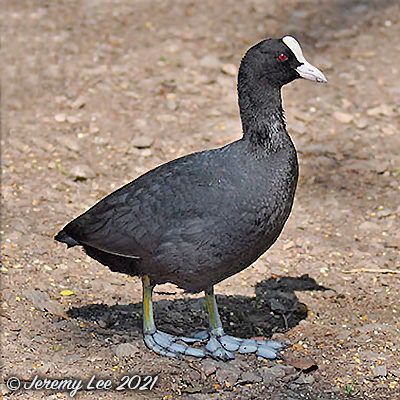
 |
|
Scientific Classifications explained » Amphibians » Ants » Aphids » Bees » Beetles » Birds » Bugs » Butterflies » Caterpillars » Damselflies » Dragonflies » Earwigs » Flies » Frog/Leafhoppers » Fungi » Galls » Grasshoppers » Harvestmen » Hoverflies » Lacewings » Ladybirds » Leaf Mines » Lichens » Mammals » Millipedes » Mosses » Moths » Sawflies » Slugs » Snails » Spiders » Trees & Shrubs » Wasps » Wild Flowers » Woodlice » Postboxes |
UK Nature > Birds > Fulica atra

Scientific Name: Fulica atra Common Name: Coot Fulica atra, more commonly known as the Coot, is approximately 38cm in length. The adult bird is easily recognised by sooty-black plumage with white bill and frontal shield and greenish-yellow legs and grey feet. In winter they are gregarious, and can be found in large flocks on lakes, reservoirs and sheltered estuaries and bays. Dives frequently. Swims with nodding head movements and runs a long way across water surface to take off. Many calls; typical ones include a loud, broken 'kowk, kowk' and an explosive 'pitts'. Diet consists of small aquatic animals, insect larvae and pondweed. Coots may also graze on waterside grass. Nest is a mound of waterside vegetation, reeds, sticks etc, collected from the vicinity and usually contsructed in the middle of waterside reeds etc. Common throughout most of the UK on well-vegetated lowland lakes and ponds. Rarely found in northern Scotland or on hilly high ground. |
|

https://www.uknature.co.uk is a website dedicated to showing the immense diversity of UK nature and wildlife. Our vast range of habitats, from lowland arable to snow covered mountains, from storm-ravaged coastlines to peaceful inland freshwater lakes and rivers, from dry, sandy heaths to deciduous and coniferous forests, all these habitats contribute to the abundance of UK nature. We have wild birds in huge numbers either residing or visiting our shores (597 recorded species as at July 2013) and we must also not forget the humble back garden with its grass lawns, flower beds filled with nectar rich flowers, shrubs and trees, all designed to attract huge numbers of insects such as bees, moths, butterflies and hoverflies; and finally the small ponds which provide safe havens for frogs, toads, newts and even slow worms and grass snakes. www.uknature.co.uk is the showcase for my personal passion, photographing uknature in all its glory. I sincerely hope you all enjoy the fruits of my labours. This site and all images contained therein is © Jeremy Lee 2004 - 2025. All Rights Reserved. Site design by Jeremy Lee. Site development & IT Support by Stuart Lee. |